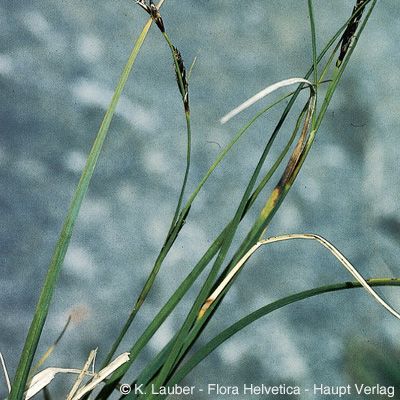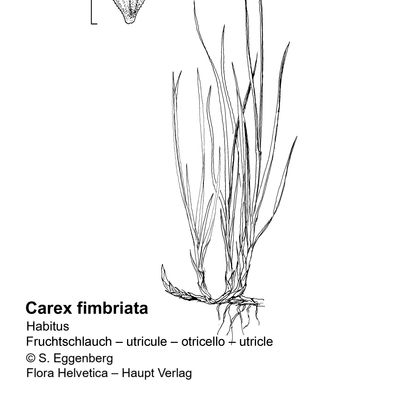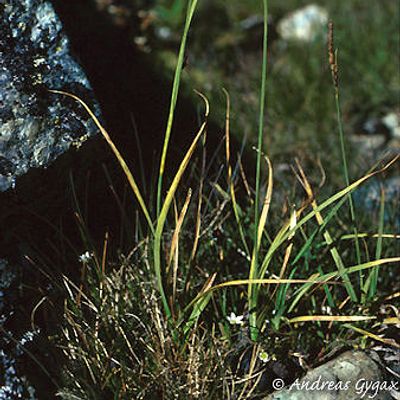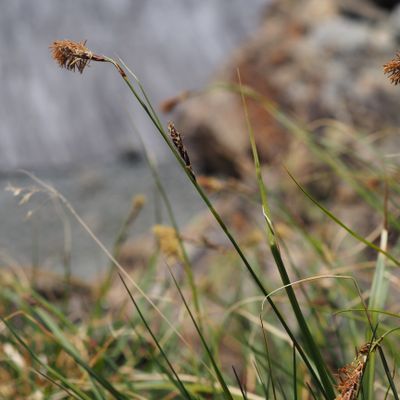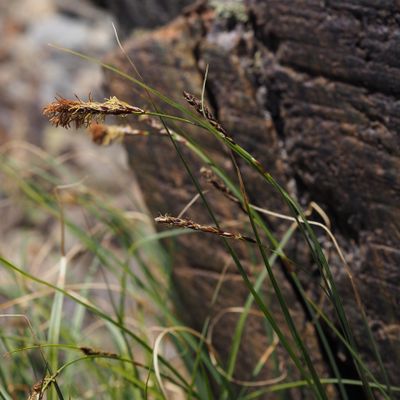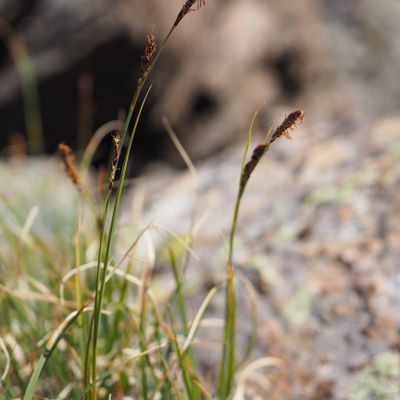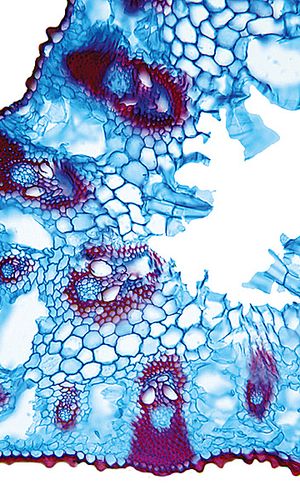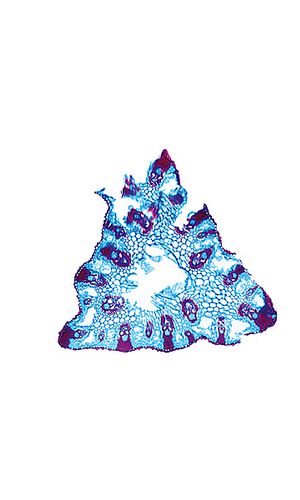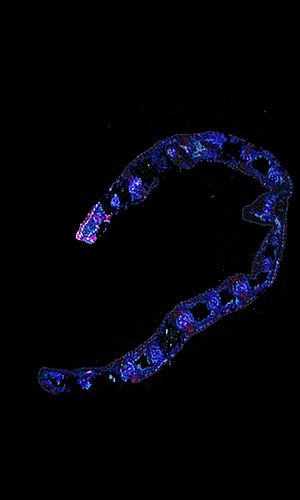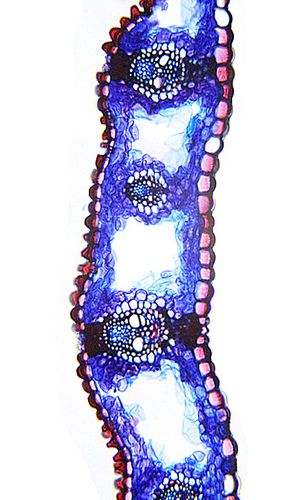Carex fimbriata Schkuhr
1009740
Species
ISFS : 87300
Checklist : 1009740
ISFS : 87300
Checklist : 1009740
Contains :
Synthesis
Species description (© Flora Helvetica 2018)
Ähnlich wie C. ferruginea, aber Blätter 2-3 mm breit, steif, Stängel scharf 3kantig und etwas rau, weibliche Ähren stets aufrecht, nur die unterste lang gestielt.Flowering period (© Flora Helvetica 2018)
7-8Habitat and distribution inside Switzerland (© Flora Helvetica 2018)
Feuchte Felsspalten / alpin / VS (Zermatt), GR (Misox, Puschlav)World distribution (© Flora Helvetica 2018)
MittelalpinEcological indicator (© Landolt & al. 2010)
331-513.h.2n=42Status
IUCN status
Near threatenedNational Priority
3 - medium national priorityInternational responsibility
3 - highConservation
Threats
Touristische Erschliessung (Infrastruktur, Seilbahnen, Strassen, etc.), Militärvorhaben, Elektrizitätswirtschaft
Intensive Beweidung
Anatomy
Summary of leaf anatomy (German)
Obere Epidermiszellen grösser als untere. Epidermis mit Papillen.Verbindungs-Steg zwischen oberer und unterer Epidermis aus verholzten und nicht verholzten Zellen. Leitbündel im Verbindungs-Steg in der Mitte eingebettet. Leitbündelhülle nicht verholzt.Summary of stem anatomy (German)
Umriss exakt dreieckig. Leitbündel in mehreren Reihen. Rechteckige Stützen. Kleine Interzellularen, oft dreieckig. Grosse, unregelmässige Intercellularen. Epidermiszellen aussen verholzt. Epidermiszellen mit Papillen.Description
Culm-diameter 1-2 mm, wall very large, radius of culm in relation to wall thickness approximately 1: 0.75. Outline triangular, acutely. Culm-center hollow and surrounded by many large thin-walled, not lignified cells. Epidermis papillous (bulliform). Epidermis cells inside thin, peripheral thicker-walled (lignified). Large vascular bundles arranged in 2-3 peripheral rows. Small or rudimentary vascular bundles within the chlorenchyma. Chlorenchyma in round, oval, square or rectangular groups. Sclerenchyma belt absent. Groups of sclerenchyma square or rectangular. Vascular bundles collateral closed. Sclerenchymatic sheath around vascular bundles circular large, 3 to x cells. Vessels arrangement in vascular bundles in lateral position. Largest vessel in the bundle 20-50 μm. Cavities (intercellulars) between parenchyma-cells small, often triangular. Cavities (intercellulars) between parenchymacells round, oval or radial. Distinct cavities (intercellulars) in the protoxylem area of vascular bundles. Crystals absent.Distribution map
Habitat and distribution inside Switzerland
VS (Zermatt), GR (Misox, Puschlav)World distribution
MittelalpinEcology
Life form
Perennial hemicryptophyte
Habitats
Milieux Phytosuisse (© Prunier et al. 2017)
Habitats © Delarze & al. 2015
 | 4.3.7 - Krummseggenrasen (Caricion curvulae) |
bold
Dominant species, influencing the appearance of the habitat
 Character species
Character species
 Less strictly linked to a specific habitat
Less strictly linked to a specific habitat
Ecological indicator values by © Landolt & al. (2010)
| Soil factors | Climatic factors | Salinity tolerance | |||
|---|---|---|---|---|---|
| Humidity Value H | 3 | Light Value L | 5 | Salinity Index | -- |
| Reaction Value R | 3 | Temperature factor T | 1 | ||
| Nutriments value N | 1 | Continentality K | 3 | ||
- Ecological values legend
Humidity Value H 1 very dry 1+ dry 2 moderatly dry 2+ moist 3 medium wet 3+ wet 4 very wet 4+ soggy 5 submerged or underwater f plants living in running water u mostly submerged plants v partly submerged, partly floating plants w humidity moderately variable (± scale of 1-2) w+ highly variable humidity (scale exceeding ± 2) Reaction Value R 1 Very acid (pH 2.5-5.5) 2 acid (pH 3.5-6.5) 3 lightly acid to neutral (pH 4.5-7.5) 4 neutral to basic (pH 5.5-8.5) 5 basic (pH 6-5 -> 8.5 Nutriments value N 1 very low in nutrients 2 low in nutriments 3 medium-poor to medium-rich in nutrients 4 rich in nutriments 5 very rich in nutriments Salinity tolerance 1 halotolerant 3 halophyle Light Value L 1 very shady 2 shady 3 lighted areas 4 luminous 5 highly luminous Temperature factor T 1 alpine to nival stages (from the treeline to the snowline) 1+ suprasubalpine and upper subalpine levels (pine and larch forests) 2 subalpine level (coniferous forests without beeches up to the upper limit of spruces) 2+ lower subalpine and upper mountain stages 3 mountain level (beech and silver fir forests, in the central Alps Scots pine forests) 3+ lower mountain and upper hill levels 4 hill level (mixed deciduous oak forests) 4+ hot places, hill level 5 very hot places, hill level (only in the hottest places, typical of southern Europe) Continentality K 1 Atlantic (high air humidity, very low temperature variations, mild winters) 2 Sub-Atlantic (high air humidity, low temperature variations, relatively mild winters) 3 sub-Atlantic to subcontinental (average air humidity, moderately variable temperature, slightly low winter temperatures) 4 subcontinental (low air humidity, large temperature variations, rather cold winters) 5 continental (very low air humidity, very large temperature variations, cold winters)
Water dependency
| Rivers | 0 - No link |
| Calm water | 0 - No link |
| Ground water | 0 - No link |
Nomenclature
Accepted Name (Checklist 2017)
Carex fimbriata Schkuhr
Vernacular name
Deutscher Name :
Fransen-SeggeNom français :
Laîche frangéeNome italiano :
Carice sfrangiataMatch with other reference books
| Relation | Nom | Book | No |
|---|---|---|---|
| = | Carex fimbriata Schkuhr | Checklist 2017 | 87300 |
| = | Carex fimbriata Schkuhr | Flora Helvetica 2001 | 2582 |
| = | Carex fimbriata Schkuhr | Flora Helvetica 2012 | 2758 |
| = | Carex fimbriata Schkuhr | Flora Helvetica 2018 | 2758 |
| = | Carex fimbriata Schkuhr | Index synonymique 1996 | 87300 |
| = | Carex fimbriata Schkuhr | Landolt 1977 | 543 |
| = | Carex fimbriata Schkuhr | Landolt 1991 | 479 |
| = | Carex fimbriata Schkuhr | SISF/ISFS 2 | 87300 |
| = | Carex fimbriata Schkuhr | Welten & Sutter 1982 | 2496 |
= The taxon corresponds to the accepted taxon (Checklist 2017)
< The taxon is included in the accepted taxon (Checklist 2017)
> The taxon includes (among others) also the accepted taxon (Checklist 2017)
< The taxon is included in the accepted taxon (Checklist 2017)
> The taxon includes (among others) also the accepted taxon (Checklist 2017)
Status
Native status
-IUCN list of endangered species (© Walter & Gillett 1997) : Yes
Status on national Red List 2016
IUCN status:
Near threatened

Additional information
IUCN criteria: D2
Status on regional Red List 2019
| Biogregraphic regions | Status | IUCN criteria |
|---|---|---|
| Jura (JU) | -- | |
| Mittelland (MP) | -- | |
| Alpennordflanke (NA) | -- | |
| Alpensüdflanke (SA) | NT | D2 |
| Östliche Zentralalpen (EA) | -- | |
| Westliche Zentralalpen (WA) | NT | D2 |
- Legend
EX Extinct RE Regionally Extinct CR(PE) Critically Endangered, Probably Extinct CR Critically Endangered EN Endangered VU Vulnerable NT Near Threatened LC Least Concern DD Data Deficient NE Not Evaluated NA Not Applicable
National Priority Species List Status
| National Priority | 3 - medium national priority |
| Need to take action | 0 - mesures needed |
| International responsibility | 3 - high |
| Need to monitor populations | 1 - |
Protection status
| International (Bern Convention) | No | |
| TI | total protection | (23.01.2013) |
| Switzerland | -- |
- Disclaimer
InfoFlora compiles information on protected species as accurately as possible, taking it from the respective cantonal laws. In some cases, however, it was not possible to use the plant names as listed in the original text, but an interpretation of their taxonomy or nomenclature was necessary. The exact meaning of the categories „completely protected“ and „partially protected“ differs among the cantons.
InfoFlora cannot guarantee that the information on the protection status is correct and complete. In case of doubts, we recommend to look up the texts of the respective cantonal law.
Status by sector of activity
| Agriculture-related environmental objectives : | more informations | |
| Forest management environmental objectives : | more informations |
Conservation
Threats and measures
Touristische Erschliessung (Infrastruktur, Seilbahnen, Strassen, etc.), Militärvorhaben, Elektrizitätswirtschaft
Kein Ausbau der bestehenden touristischen Infrastruktur, keine Neuerschliessungen
Infrastruktur der Elektrizitätswirtschaft nicht ausbauen
auf wertvolle Gebiete Rücksicht nehmen
Intensive Beweidung
Fundbereiche nutzen wie bisher
keine Intensivierung
